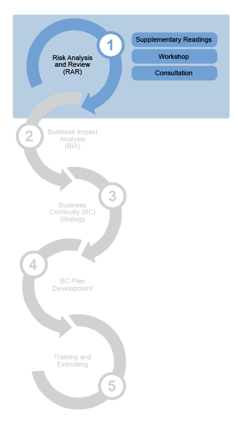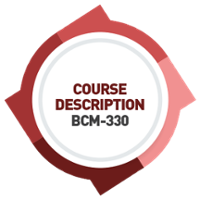Overview of BCM-310 (Session 1)
Running the Risk Assessment
At this stage, the appointed business unit (BU) BCM coordinator is about to attend the first BCM workshop that has been organised in-house.

This article is the 2nd part of the BCM Training-led Implementation series (assuming you have completed the Project Management 1A and 1B modules). This is the reading for participants embarking on a BCM implementation training with experienced BCM professionals facilitating as part of a workshop to guide the participants in developing and implementing the BCM organisation.
This "Risk Analysis and Review" or "RAR" phase [the second phase of the BCM planning methodology] involved the "Running a risk assessment" training, which entails the following steps.
1. Supplementary Readings
Participants will receive regular emails that direct them to BCM Institute's Learning Management System (LMS) or eCampus.
They can view content that is similar to what you are reading now. It contains bite-size pre-reading information on risk analysis and review.
This is done to introduce them to the fundamental concepts ahead of the coming series of five more workshops, helping to optimize their time at the workshops.
What should participants do "Before" the Online Workshop?
- Read the supplementary pre-reading materials before the workshop
- Complete the two E-Learning Modules, "Overview of BCM" and "Risk Analysis and Review".
- Download the softcopy RAR templates from the eCampus
- Start filling in their RAR templates downloaded from
eCampus, with the assistance of the guidance notes
- Highlight the content you are unsure about being asked about during the coming workshop.
2. Facilitated Workshop
.png?width=300&name=BL-B-3%20Run2%20ZOOM%20-%20Copy%20(2).png)
A workshop will be conducted to guide participants in analyzing and evaluating their risks. The facilitator will also use this time to explain the more complex concepts of risk. A set of templates is used to facilitate this process.
This will give them the necessary information and context to understand some key concepts involved in Risk Analysis and Review them before the online workshop session.
It is important to note that the workshop is a 1-time group event. Hence, participants must lock this event in their calendars. No repeat workshop will be conducted for absent participants, and there is a possibility that BCM Institute will not pass the participant if he/she is not present during the class.
Summary of what participants should do "During" and "After" the workshop?
Participants (or BU BCM Coordinators) are required to:
During Workshop
- Attend the workshop and clarify any queries during the class as the facilitator walks through the template sequentially during the workshop.
After Workshop
- Amend and submit your RAR templates via the eCampus submission finalized and finalise your template based on the comments written on your returned submission email by the Facilitator.
- Rename your file as Version 2.0 or V 2.0 and finalise the finalized "reviewed" business unit or BU's RAR template submission via upload to BCM Institute's eCampus portal.
- Submit within two working days after the workshop.
- All submitted RAR templates from all the BUs will be batched to the Organisation BCM Coordinator for final consolidation and reporting
3. Consultation with Project Team Leader [Online]
Subject to Prior Agreement. After the workshop, participants will have two working days (after completion) to complete and submit the templates via the eCampus portal.
The consolidated submission will be batched to the appointed Organisation BCM Coordinator, who will consolidate the templates and develop the first draft of the report.
 Optional: A complimentary one-hour consultation session will be arranged for the Organisation BCM Coordinator to review the compiled templates/ report with the facilitator. This session is subject to the initial conditions and class size as agreed upon during the start of the project.
Optional: A complimentary one-hour consultation session will be arranged for the Organisation BCM Coordinator to review the compiled templates/ report with the facilitator. This session is subject to the initial conditions and class size as agreed upon during the start of the project.
 What Preparation does the Organisation BCM Coordinator need to do "Before" the consultation session:
What Preparation does the Organisation BCM Coordinator need to do "Before" the consultation session:
- Get the "RAR report to management" template from the facilitator. This is optional.
- Get all BU BCM Coordinators to submit their completed RAR template after attending the instructor's online session. The BU BCM Coordinators are expected to edit their business unit or BU's RAR template after the online workshop session.
- Before the consultation session, comments will be emailed to the designated facilitator.
- Attend the consultation session at the appointed time (on Zoom)
- Process the templates from all BU and write a report for the submorganization's management.
- Re-edit the compiled RAR report and prepare to present the revised RAR report for management presentation.
 The strength of this program is the continuity of BCM knowledge should the officer responsible for BCM be replaced. If you are attending a public course, this course is similar to the previous session for BCM-310 (Course code), titled "Assessing Risk and Business Impact Requirements" or click icon on the right for more information.
The strength of this program is the continuity of BCM knowledge should the officer responsible for BCM be replaced. If you are attending a public course, this course is similar to the previous session for BCM-310 (Course code), titled "Assessing Risk and Business Impact Requirements" or click icon on the right for more information.
Once this session is completed, the BU BCM Coordinators are ready to attend the next "Business Impact Analysis" workshop in session 1B.
BCM Project Planning
If you have not read the first two articles regarding how this project started, clicking icons [1A] and [1B] may help you understand how a typical project starts.
Ignore if you have completed the BCM-410 course or already have a BCM policy and framework.
Training of New Coordinators
 If you have a new business unit BCM coordinator and need the knowledge for "Risk Analysis and Review", your colleague can attend a similar public course, BCM-310 (Course code).
If you have a new business unit BCM coordinator and need the knowledge for "Risk Analysis and Review", your colleague can attend a similar public course, BCM-310 (Course code).
Training-led BCM Implementation Roadmap




![[BCM] [EL] [L1] Overview of Business Continuity Management](https://no-cache.hubspot.com/cta/default/3893111/4aff87a7-a3c8-4732-9404-27b07a67d66d.png)
![[BCM] [EL] [L3] Risk Analysis and Review](https://no-cache.hubspot.com/cta/default/3893111/458f984b-f134-46a4-a3ca-45780efef255.png)

![[ITL] [1B] [PM] BCM Training-led Implementation: Developing BCM Structure and Framework](https://no-cache.hubspot.com/cta/default/3893111/304ac1bb-a4a1-426b-9724-838c7052807a.png)
![[ITL] [2] [RAR] Training-led BCM Implementation: Running the Risk Assessment](https://no-cache.hubspot.com/cta/default/3893111/667b23cb-0ff8-4d09-ae4e-0b54f000e353.png)
![[ITL] [4] [BCS] Training-led BCM Implementation: Evaluating the Business Continuity Strategy](https://no-cache.hubspot.com/cta/default/3893111/fed0fded-5b6a-42da-95b6-2788b0597ab1.png)
![[ITL] [6] [TE] Training-led BCM Implementation: Executing Tests and Exercises](https://no-cache.hubspot.com/cta/default/3893111/8971336e-4d4d-4ef5-b274-96b552356db5.png)
![[ITL] [3] [BIA] Training-led BCM Implementation: Executing the Business Impact Analysis](https://no-cache.hubspot.com/cta/default/3893111/d00710d6-0650-45b7-97aa-7ccde268d7b9.png)







